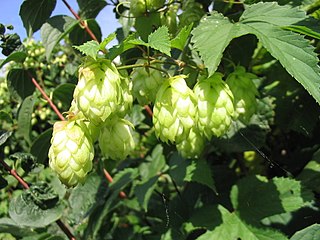Related Research Articles

Humulus, hop, is a small genus of flowering plants in the family Cannabaceae. The hop is native to temperate regions of the Northern Hemisphere. Hops are the female flowers of the hop species H. lupulus; as a main flavor and aroma ingredient in many beer styles, H. lupulus is widely cultivated for use by the brewing industry.

Humulus lupulus, the common hop or hops, is a species of flowering plant in the hemp family Cannabaceae, native to Europe, western Asia and North America. It is a perennial, herbaceous climbing plant which sends up new shoots in early spring and dies back to a cold-hardy rhizome in autumn. It is dioecious.
The BBCH-scale is used to identify the phenological development stages of plants. BBCH-scales have been developed for a range of crop species where similar growth stages of each plant are given the same code.
In biology, the BBCH-scale for beans describes the phenological development of bean plants using the BBCH-scale.
In biology, the BBCH-scale for beet describes the phenological development of beet plants using the BBCH-scale.
In biology, the BBCH-scale for bulb vegetables describes the phenological development of bulb vegetable plants, such as onion, leek, garlic and shallot, using the BBCH-scale.
The BBCH-scale for citrus is a classification system used in biology to describe the phenological development of citrus plants using the BBCH-scale.
In biology, the BBCH-scale for cotton describes the phenological development of cotton plants Gossypium hirsutum using the BBCH-scale.
In biology, the BBCH-scale for cucurbits describes the phenological development of cucurbits, such as cucumber, melon, pumpkin, marrow, squash, calabash and watermelon, using the BBCH-scale.
In biology, the BBCH-scale for currants describes the phenological development of currants, such as blackcurrants and redcurrants, using the BBCH-scale.
In biology, the BBCH-scale for grapes describes the phenological development of grapes using the BBCH-scale.
In biology, the BBCH-scale for musaceae describes the phenological development of musaceae using the BBCH-scale.
In biology, the BBCH-scale for peas describes the phenological development of peas using the BBCH-scale.
In biology, the BBCH-scale for peanut describes the phenological development of peanuts using the BBCH-scale.
The BBCH-scale for root and stem vegetables identifies the phenological development stages of the root and stem vegetables such as carrot, celeriac, kohlrabi, chicory, radish and swede, using the BBCH-scale.
The BBCH-scale (strawberry) identifies the phenological development stages of strawberry. It is a plant species specific version of the BBCH-scale.
In biology, the BBCH-scale for leafy vegetables forming heads describes the phenological development of leafy vegetables forming heads, such as cabbage, chinese cabbage, lettuce and endive, using the BBCH-scale.
In biology, the BBCH-scale for leafy vegetables not forming heads describes the phenological development of leafy vegetables not forming heads, such as spinach, loosehead lettuce, and kale, using the BBCH-scale.

Humulone, a vinylogous type of organic acid, is a bitter-tasting chemical compound found in the resin of mature hops. Humulone is a prevalent member of the class of compounds known as alpha acids, which collectively give hopped beer its characteristic bitter flavor.

8-Prenylnaringenin is a prenylflavonoid phytoestrogen. It is reported to be the most estrogenic phytoestrogen known. The compound is equipotent at the two forms of estrogen receptors, ERα and ERβ, and it acts as a full agonist of ERα. Its effects are similar to those of estradiol, but it is considerably less potent in comparison.
References
- Rossbauer, G.; L. Buhr; H. Hack; S. Hauptmann; R. Klose; U. Meier; R. Staus; E. Weber (1995). "Phänologische Entwicklungsstadien von Kultur-Hopfen (Humulus lupulus L.)": 249–253.Cite journal requires
|journal=(help)